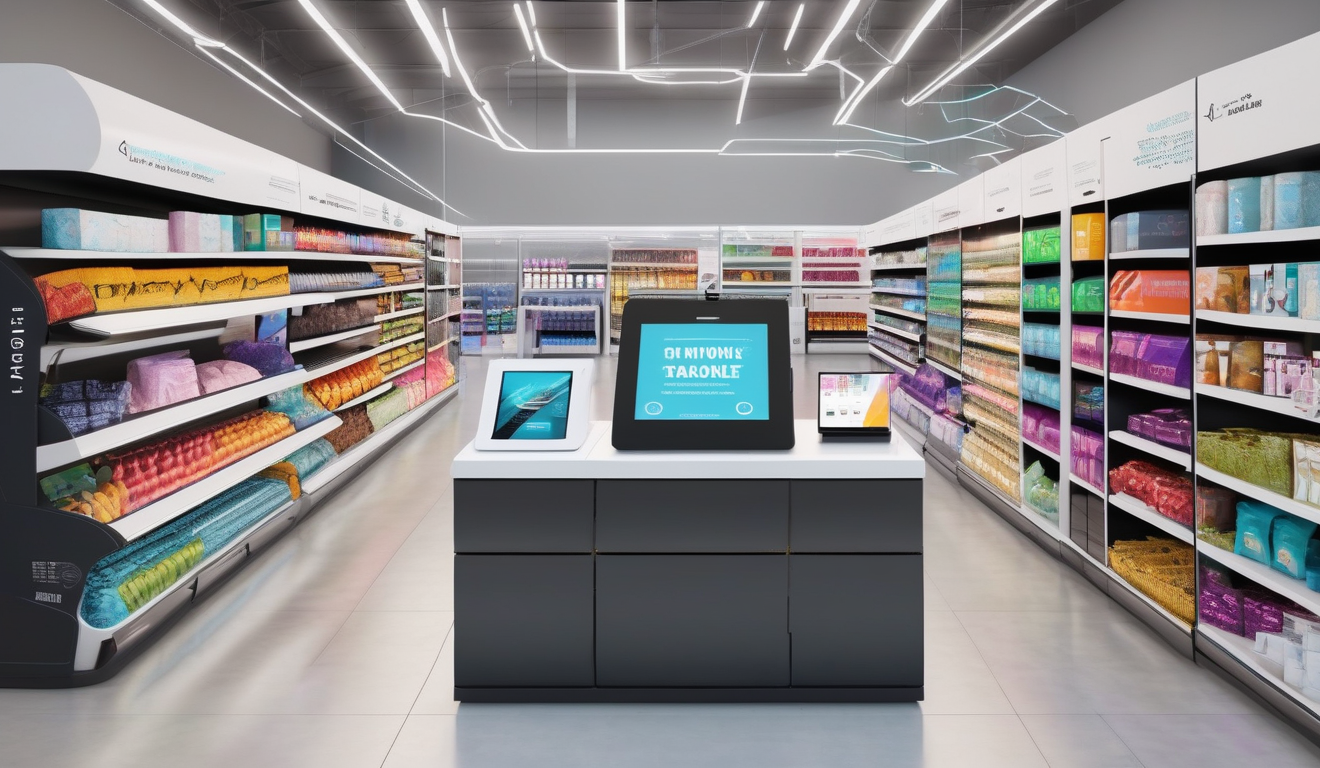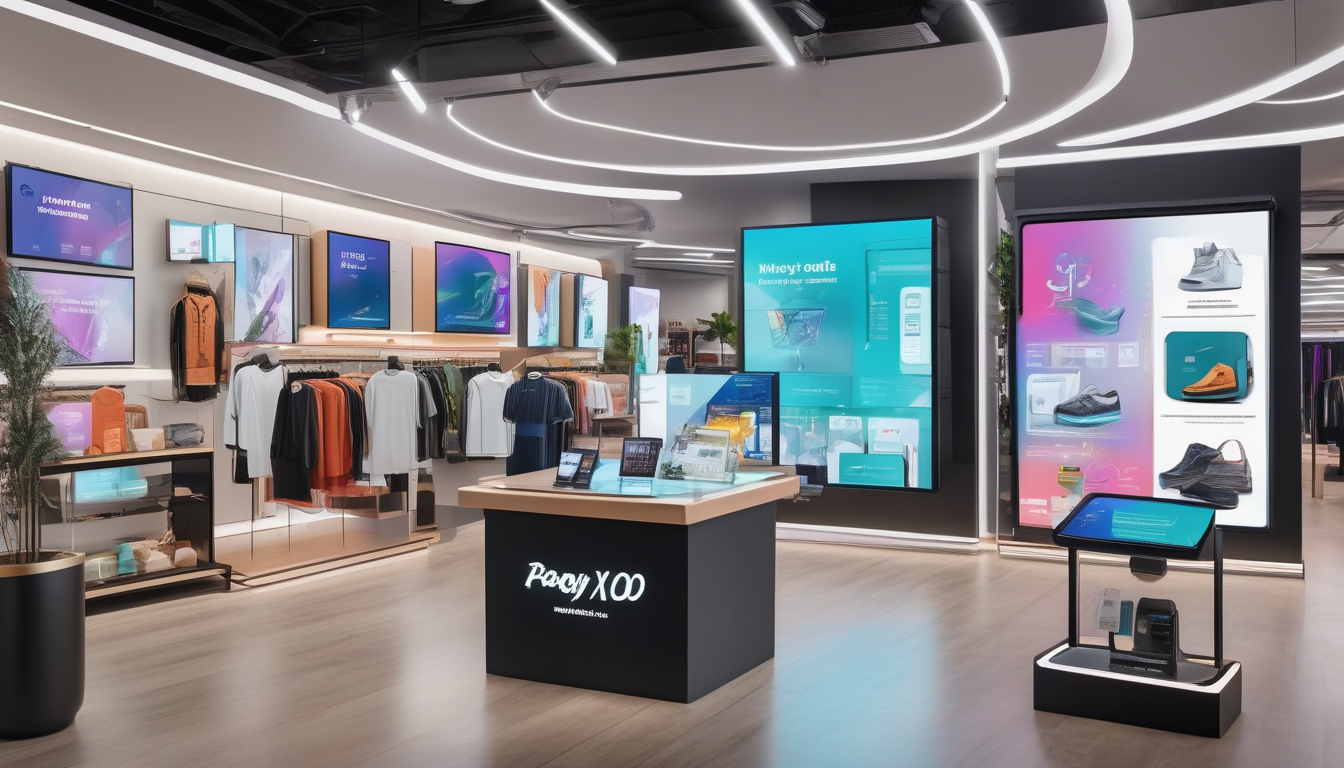How AI Is Transforming the Retail Industry

Artificial Intelligence (AI) is not just a buzzword; it’s a game-changer in the retail sector. Imagine walking into a store that knows your preferences better than you do! With AI, that’s becoming a reality. Retailers are leveraging advanced algorithms and machine learning to create a shopping experience that feels personal and engaging. From personalized recommendations to tailored promotions, AI is enhancing customer interactions in ways we never thought possible.
Moreover, the integration of AI technologies is allowing retailers to analyze vast amounts of data to understand consumer behavior like never before. This means that when you browse online, the products displayed are not random; they are carefully curated based on your past interactions, preferences, and even the time of day. It’s like having a personal shopper who knows exactly what you need!
AI technologies are revolutionizing how retailers interact with customers, personalizing shopping experiences and providing tailored recommendations that meet individual preferences and needs. Imagine receiving a notification on your phone about a sale on your favorite brand just as you’re considering a purchase. This is the power of AI-driven marketing strategies that engage customers at the right moment.
Inventory management is another area where AI shines. By utilizing AI-driven analytics, retailers can predict demand trends with remarkable accuracy. This minimizes overstock and stockouts, ultimately reducing costs. Think of it as a well-oiled machine that runs smoothly—no more excess inventory gathering dust, and no more disappointed customers finding empty shelves.
Predictive analytics uses historical data to forecast future sales, enabling retailers to make informed decisions about inventory and supply chain management for better profitability. With this technology, retailers can anticipate customer demand, ensuring that popular items are always in stock.
Various demand forecasting techniques, such as time series analysis and machine learning models, are employed to enhance accuracy and responsiveness in inventory management. This means retailers can adapt quickly to market changes, keeping them one step ahead of the competition.
Real-time inventory tracking systems utilize AI to provide up-to-the-minute data, allowing retailers to adjust stock levels dynamically and respond to customer demand instantly. It’s like having a crystal ball that tells you exactly what your customers want, when they want it!
AI enhances supply chain efficiency by streamlining processes, reducing lead times, and improving logistics through advanced data analysis and automation technologies. This not only saves time but also enhances the overall customer experience by ensuring that products are delivered quickly and efficiently.
AI transforms marketing in retail by enabling hyper-targeted campaigns, improving customer segmentation, and automating content creation to enhance engagement and conversion rates. With AI, marketing is no longer a shot in the dark; it’s a precise science that drives results.
Using AI algorithms, retailers can create personalized marketing campaigns that resonate with individual consumers, increasing relevance and driving sales. This level of personalization makes customers feel valued and understood, fostering loyalty and repeat business.
AI-powered chatbots and virtual assistants provide 24/7 customer support, answering queries and assisting with purchases, thereby enhancing customer satisfaction and loyalty. Picture this: it’s midnight, and you have a question about your order. Instead of waiting until morning, a chatbot is there to help you instantly. How convenient is that?

Enhancing Customer Experience
Artificial Intelligence is not just a buzzword; it’s a game-changer in the retail world! Imagine walking into a store where the products seem to know you better than your best friend. AI technologies are revolutionizing how retailers interact with their customers, making shopping experiences not only personalized but also incredibly engaging. From tailored recommendations to smart chatbots, AI is the secret sauce that enhances customer satisfaction.
One of the most exciting aspects of AI is its ability to analyze vast amounts of data to understand customer preferences. For instance, when you browse online, AI algorithms track your behavior, learning what you like and dislike. This means that the next time you visit a retail website, you’re greeted with suggestions that feel almost psychic! Isn’t that a delightful surprise? This level of personalization creates a stronger emotional connection between the customer and the brand.
Furthermore, AI enhances the in-store experience as well. Picture this: you walk into a store, and a friendly virtual assistant greets you, ready to help you find exactly what you’re looking for. This is not just a fantasy; it’s happening now! Retailers are using AI-powered kiosks and apps that provide instant information about product availability, promotions, and even personalized discounts. Customers can feel like VIPs, receiving attention tailored just for them.
Moreover, AI chatbots are stepping up customer service like never before. These digital helpers are available 24/7, answering queries and assisting with purchases, ensuring that no question goes unanswered. This immediate support can significantly enhance customer satisfaction and loyalty. Imagine having a shopping assistant that never sleeps!
In summary, the integration of AI in retail is like adding a high-tech twist to the traditional shopping experience. It’s not just about selling products; it’s about creating memorable interactions that keep customers coming back for more. As retailers continue to adopt these innovative technologies, the future of shopping looks brighter and more personalized than ever!

Optimizing Inventory Management
In today’s fast-paced retail environment, is more crucial than ever. Retailers are turning to AI-driven analytics to streamline their operations, ensuring they have the right products available at the right time. Imagine being able to predict which items will fly off the shelves and which will linger, all thanks to the power of artificial intelligence!
One of the standout features of AI in inventory management is its ability to harness predictive analytics. By analyzing historical data, AI can forecast future sales with impressive accuracy. This means retailers can make informed decisions about what to stock and when, minimizing the dreaded overstock and stockouts that can frustrate customers and hurt profits. Think of it as having a crystal ball that helps you see into the future of your sales!
To achieve this level of insight, retailers employ various demand forecasting techniques. Some of the most effective methods include:
- Time Series Analysis: This technique looks at historical sales data to identify patterns over time, helping retailers anticipate future demand.
- Machine Learning Models: These advanced algorithms learn from data and can adapt to changing trends, providing even more accurate forecasts.
Another key aspect of optimizing inventory management is real-time inventory tracking. With AI-powered systems, retailers can access up-to-the-minute data on stock levels. This capability allows them to adjust their inventory dynamically, responding to shifts in consumer demand almost instantly. Imagine walking into a store and finding exactly what you need because the retailer has already adjusted their stock based on real-time data!
Furthermore, AI doesn’t just stop at inventory management; it plays a vital role in supply chain optimization as well. By streamlining processes and reducing lead times, AI enhances overall efficiency. Retailers can analyze vast amounts of data to identify bottlenecks and improve logistics, resulting in a smoother operation from warehouse to store.
In conclusion, the integration of AI in inventory management is not just a trend; it’s a game-changer. Retailers who embrace these technologies will not only enhance their operational efficiency but also provide a better shopping experience for their customers. With AI, the future of inventory management is looking brighter than ever!
Predictive Analytics
Imagine walking into a store where every product seems to know exactly what you want. This is the magic of , a game-changing tool that leverages historical data to forecast future sales trends. Retailers are no longer guessing what customers might want next season; they are making informed decisions based on solid data. By analyzing past purchasing behaviors, seasonal trends, and even external factors like economic conditions, retailers can accurately predict what items will fly off the shelves.
But how does this really work? Think of predictive analytics as a crystal ball for retailers. It combines various data sources to create a comprehensive view of customer preferences. Here’s a simple breakdown of the process:
- Data Collection: Retailers gather data from multiple channels, including sales records, customer feedback, and social media interactions.
- Data Analysis: Advanced algorithms sift through this data, identifying patterns and correlations that may not be immediately obvious.
- Forecasting: Based on these insights, retailers can project future sales, allowing for proactive inventory management.
This approach not only enhances inventory management but also boosts profitability. For instance, if a retailer identifies a surge in demand for a particular item, they can adjust their inventory levels accordingly, reducing the risk of stockouts and ensuring that customers find what they’re looking for. Conversely, if a product is predicted to underperform, they can minimize overstock, thus avoiding unnecessary markdowns.
Moreover, predictive analytics doesn’t just stop at inventory; it extends to various facets of retail operations. For example, it can inform marketing strategies by identifying which products are likely to be popular, allowing for targeted promotions that resonate with customers. The result? A more efficient operation that maximizes both customer satisfaction and profit margins.
In summary, predictive analytics is like having a superpower in the retail world. It empowers retailers to make data-driven decisions, ensuring they meet customer demands while optimizing their operations. As AI technologies continue to evolve, the potential of predictive analytics will only grow, making it an essential tool for any retailer aiming to thrive in a competitive landscape.
Demand Forecasting Techniques
When it comes to demand forecasting, retailers have a plethora of techniques at their disposal, each designed to enhance accuracy and responsiveness in inventory management. Imagine trying to predict the weather without the right tools; similarly, retailers need reliable methods to anticipate customer needs. One of the most popular approaches is time series analysis, which uses historical sales data to identify patterns and trends over time. This technique allows retailers to make educated guesses about future demand based on past behavior.
Another powerful method is the use of machine learning models. These algorithms analyze vast amounts of data, learning from it to improve their predictions continuously. Think of it like training a pet; the more you interact and feed it information, the better it gets at responding to your cues. Machine learning can help retailers understand complex relationships in their data, leading to more accurate forecasts.
To illustrate how these techniques work, let’s take a look at a simple comparison table:
| Technique | Strengths | Weaknesses |
|---|---|---|
| Time Series Analysis | Easy to implement, good for stable trends | Less effective with sudden changes |
| Machine Learning | Handles complex data, adapts over time | Requires significant data and resources |
Moreover, retailers are increasingly adopting real-time inventory tracking systems. These systems leverage AI to provide up-to-the-minute data on stock levels, allowing businesses to adjust their inventories dynamically. Imagine a chef who knows exactly how many ingredients are left before dinner service; this level of awareness can significantly enhance a retailer’s ability to meet customer demand without overstocking.
In summary, the combination of traditional techniques like time series analysis with cutting-edge machine learning models and real-time tracking creates a robust framework for demand forecasting. By harnessing these strategies, retailers can not only improve their inventory management but also enhance overall customer satisfaction, making sure that when shoppers come calling, the products they want are right there on the shelves.
Real-time Inventory Tracking
In today’s fast-paced retail environment, has emerged as a game-changer. Imagine being able to know exactly what products are on your shelves at any given moment, just like a chef knows the precise ingredients in their kitchen. This technology allows retailers to monitor stock levels continuously, providing them with the agility to respond swiftly to customer demands.
With the integration of AI, real-time inventory tracking systems leverage advanced data analytics to provide up-to-the-minute information. This means retailers can identify trends and patterns that were previously hidden. For instance, if a particular product starts flying off the shelves, retailers can quickly adjust their inventory levels to meet the surge in demand. This not only enhances customer satisfaction but also minimizes the risk of stockouts, which can lead to lost sales.
Moreover, the benefits of real-time inventory tracking extend beyond just knowing what’s on hand. It also includes:
- Improved Accuracy: Automated systems reduce human error, ensuring that inventory counts are precise.
- Cost Efficiency: By minimizing overstock and stockouts, retailers can significantly cut costs associated with excess inventory and emergency restocking.
- Enhanced Decision-Making: Retailers can make data-driven decisions regarding purchasing and promotions based on real-time insights.
For example, consider a clothing retailer that uses real-time tracking to manage seasonal inventory. By analyzing sales data and stock levels in real time, they can quickly identify which items are trending and adjust their marketing strategies accordingly. This agility not only keeps their inventory fresh but also aligns their offerings with current consumer preferences.
In conclusion, real-time inventory tracking powered by AI is not just a technological advancement; it’s a necessity for retailers looking to thrive in a competitive landscape. By embracing this innovation, they can ensure they are always one step ahead, meeting customer needs while optimizing their operations.
Supply Chain Optimization
In today’s fast-paced retail environment, optimizing the supply chain is more crucial than ever. With the integration of artificial intelligence, retailers can transform their supply chain operations into a finely tuned machine that not only meets customer demands but also drives down costs. Imagine a world where every product is available exactly when and where it’s needed—this is the reality that AI is helping to create.
AI enhances supply chain efficiency by analyzing vast amounts of data to streamline processes. For instance, through advanced data analysis, retailers can identify bottlenecks in their supply chains and implement solutions that reduce lead times significantly. This means that products can move from manufacturer to consumer faster than ever before, ensuring that shelves are stocked with the right items at the right time.
One of the key advantages of AI in supply chain optimization is its ability to predict demand accurately. By leveraging predictive analytics, retailers can forecast sales trends based on historical data, seasonal patterns, and even social media sentiment. This proactive approach allows businesses to adjust their inventory levels accordingly, minimizing the risks of overstock and stockouts. Here’s how it works:
| Technique | Description |
|---|---|
| Time Series Analysis | Utilizes historical sales data to predict future demand. |
| Machine Learning Models | Analyzes complex datasets to uncover patterns and trends for better forecasting. |
Moreover, the implementation of real-time inventory tracking systems powered by AI ensures that retailers have up-to-the-minute data on stock levels. This capability allows businesses to react swiftly to changes in consumer demand, making adjustments to their inventory on the fly. Imagine being able to restock a popular item in real-time as soon as it sells out—this is the kind of agility that AI brings to the table.
In essence, the integration of AI into supply chain management not only enhances operational efficiency but also elevates customer satisfaction. When retailers can deliver products faster and more reliably, they not only meet but exceed customer expectations, fostering loyalty and driving sales. The future of retail is here, and it’s powered by AI.

Revolutionizing Marketing Strategies
Artificial Intelligence (AI) is not just a buzzword; it’s a game changer in the retail marketing arena. Imagine walking into a store where every product seems to have been chosen just for you. That’s the magic of AI! By analyzing consumer behavior and preferences, retailers can create hyper-targeted marketing campaigns that feel personal and relevant. This isn’t just about sending out generic emails; it’s about crafting messages that resonate with individual consumers, driving engagement and ultimately boosting sales.
One of the most exciting aspects of AI in marketing is its ability to enhance customer segmentation. Traditional methods of segmenting customers often rely on broad demographics, but AI dives deeper. It utilizes data from past purchases, browsing history, and even social media interactions to create detailed customer profiles. This allows retailers to tailor their marketing strategies effectively, ensuring that every message hits the mark. For instance, if a customer frequently buys eco-friendly products, they can receive promotions specifically for sustainable items, making them feel valued and understood.
Moreover, the rise of chatbots and virtual assistants has transformed customer service in retail. These AI-powered tools are available 24/7, ready to engage with customers, answer questions, and assist with purchases. Imagine having a personal shopping assistant that never sleeps! This not only enhances customer satisfaction but also builds loyalty, as consumers appreciate quick and efficient service. Chatbots can handle everything from simple inquiries to complex transactions, freeing up human staff to focus on more intricate customer needs.
To illustrate the impact of AI on marketing strategies, consider the following table that highlights key benefits:
| AI Marketing Feature | Benefit |
|---|---|
| Personalized Campaigns | Increases relevance and conversion rates |
| Enhanced Customer Segmentation | Targets customers more effectively |
| Chatbots | Provides 24/7 customer support |
| Data-Driven Insights | Informs marketing strategy with real-time data |
In conclusion, AI is revolutionizing retail marketing strategies by making them more personalized, efficient, and responsive. As technology continues to evolve, we can expect to see even more innovative uses of AI that will further enhance the shopping experience. Retailers who embrace these changes will not only stay ahead of the competition but also create deeper connections with their customers. Are you ready to experience the future of retail marketing?
Personalized Marketing Campaigns
In today’s fast-paced retail environment, personalization is no longer just a buzzword; it’s a vital strategy for success. With the power of AI, retailers can craft marketing campaigns that speak directly to individual consumers, making them feel valued and understood. Imagine walking into a store where every product recommendation feels tailor-made just for you. That’s the magic of personalized marketing!
AI algorithms analyze vast amounts of data, including past purchases, browsing behavior, and even social media interactions. This data-driven approach allows retailers to segment their audience more effectively and create hyper-targeted campaigns. For instance, if a customer frequently buys athletic gear, AI can trigger personalized ads for the latest running shoes or exclusive discounts on fitness apparel. This kind of targeted marketing not only increases engagement but also boosts conversion rates significantly.
Furthermore, personalized marketing extends beyond just product recommendations. It encompasses the entire customer journey, from the first interaction to post-purchase follow-ups. Retailers can use AI to send customized emails, suggest complementary products, or even offer personalized loyalty rewards. The result? Customers feel a deeper connection with the brand, leading to increased loyalty and repeat purchases.
To illustrate the impact of personalized marketing, consider the following table showcasing key benefits:
| Benefit | Description |
|---|---|
| Higher Engagement | Tailored content resonates better with consumers, increasing interaction rates. |
| Increased Sales | Personalized recommendations lead to higher conversion rates and average order values. |
| Improved Customer Loyalty | Customers are more likely to return when they feel understood and valued. |
In summary, personalized marketing campaigns powered by AI are transforming how retailers connect with their customers. By leveraging data to create meaningful interactions, brands can not only enhance the shopping experience but also drive significant business growth. So, the next time you see an ad that feels like it was made just for you, remember: that’s AI at work, making your shopping experience smarter and more enjoyable!
Chatbots and Virtual Assistants
In today’s fast-paced retail environment, are becoming essential tools for enhancing customer engagement and satisfaction. Imagine walking into a store where a friendly assistant greets you, ready to help with any questions you have. Now, picture that same experience online, available 24/7, thanks to AI-powered chatbots. These digital helpers are designed to provide instant responses to customer inquiries, making shopping more convenient than ever.
One of the most remarkable features of chatbots is their ability to understand and process natural language. This means that customers can ask questions in their own words, and the chatbot can interpret and respond appropriately. Whether it’s checking product availability, tracking an order, or providing personalized recommendations, chatbots streamline the shopping experience and reduce the need for human intervention.
Moreover, virtual assistants can gather data on customer preferences and behaviors, allowing retailers to tailor their offerings. For instance, if a customer frequently purchases athletic gear, the chatbot can suggest the latest products in that category or alert them to upcoming sales. This level of personalization not only enhances customer satisfaction but also drives sales by presenting relevant options.
To illustrate the impact of chatbots, consider the following table showcasing the benefits they bring to the retail sector:
| Benefit | Description |
|---|---|
| 24/7 Availability | Customers can get assistance anytime, improving overall satisfaction. |
| Instant Responses | Quick answers to queries reduce wait times and enhance user experience. |
| Cost Efficiency | Reduces the need for large customer service teams, saving on operational costs. |
| Data Collection | Gathers insights on customer behavior for better targeting and marketing strategies. |
As technology continues to evolve, the role of chatbots and virtual assistants in retail will only grow. They are not just a trend; they are a game-changer in how retailers connect with customers. By providing immediate support and personalized experiences, these AI-driven tools are revolutionizing the shopping landscape, ensuring that customers feel valued and understood every step of the way.
Frequently Asked Questions
- How does AI enhance customer experience in retail?
AI enhances customer experience by personalizing shopping journeys, offering tailored recommendations based on individual preferences. Imagine walking into a store where the products seem to know you—AI makes that a reality by analyzing your past purchases and browsing behavior.
- What role does predictive analytics play in inventory management?
Predictive analytics uses historical data to forecast future sales, allowing retailers to optimize inventory levels. Think of it as having a crystal ball that helps businesses anticipate demand, ensuring they have just the right amount of stock without overloading their shelves.
- How can AI improve supply chain efficiency?
AI streamlines supply chain processes by analyzing data to reduce lead times and improve logistics. It’s like having a smart assistant that constantly looks for ways to make deliveries faster and more cost-effective, ensuring products reach customers when they need them.
- What are personalized marketing campaigns?
Personalized marketing campaigns use AI algorithms to tailor messages and offers to specific consumers. Imagine receiving a special discount on your favorite product—this is the magic of AI at work, making marketing feel more relevant and engaging.
- How do chatbots and virtual assistants enhance customer support?
AI-powered chatbots and virtual assistants provide round-the-clock customer support, answering questions and assisting with purchases. It’s like having a helpful store associate available 24/7, ensuring customers get the help they need whenever they need it.













